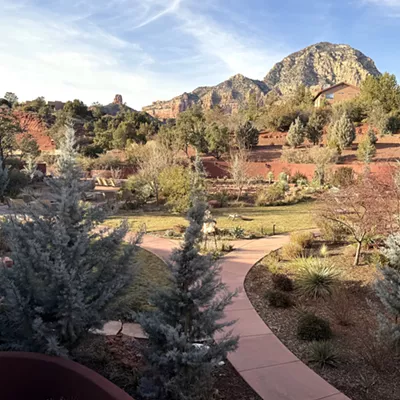In George W. Bush's America more than 20 years later, critics of these three media sources accuse them of selling out to corporate, commercial and conservative interests. As a result, these skeptics contend, in-depth coverage of important issues in Tucson has been stifled.
I was stunned when the Weekly backed the Regional Transportation Authority (RTA)," complains reader Richard Howard, "and gave nonskeptical acceptance of Don Diamond and the Southern Arizona Leadership Council. Give me a break!"
Howard adds: "They could have found the connections between the RTA and its (campaign) contributors, but didn't."
Tucson Weekly editor Jimmy Boegle points out that an anti-RTA statement--that I wrote--was included along with the positive endorsement. He also says of Howard's charge of not looking into those supporting the transportation plan and tax: "It was a no-brainer that car dealers and road builders would benefit from the RTA."
That attitude dumbfounds Howard. "Obvious to whom?" he asks. "How ridiculous can you get? Even the most mainstream journalism 101 class would follow the money. It's an absurd statement on the face of it.
"My sense is the Weekly has gone to by-the-numbers journalism," observes Howard, who called the paper "milquetoast" in a recent letter to the editor. "I remember The Skinny as more crusading, but it doesn't float my boat much anymore.
"There seem to be more Best of Tucson-type issues instead of covering vital news," Howard continues. "I see their editorial office saying, 'Get more people in the foothills reading this thing.'"
Boegle replies: "If we wanted more readers in the foothills, we'd include more sex and puff-type things." Instead, he argues the Weekly does the best it can with the writers and financial resources it has available.
"We specifically cover issues not covered or not covered well by the mainstream or other media," Boegle says. As evidence, he offers the Weekly's media column and extensive arts coverage. "We cover them because they're important, not because of the money."
Saying she stopped reading the Weekly years ago after losing faith in it, Barbara Tellman comments she only looks at the paper now if someone recommends she do so. Tellman was one of several readers who blasted the Weekly for not supporting Jeff Latas in the Democratic Congressional District 8 primary. The Weekly endorsed Gabrielle Giffords instead.
"Before, it was more of an offbeat, liberal paper," Tellman says, "but now it's going in a right (conservative) direction."
A look back at Weekly issues from its first year in 1984 shows they were 16 pages, focused on "arts, entertainment, people and places." Exemplifying this approach, an early cover story was a guide to the art of picture framing.
The paper, which now calls itself "alternative," today is usually 80 or more pages in length and has a press run of between 47,000 and 53,000. Produced out of office space near the Tucson airport, the Weekly is owned by Wick Communications, a Sierra Vista-based company that prints numerous publications around the country.
Some readers mistakenly assume Wick dictates the editorial tone of the newspaper. However, the owners do have a goal for the Weekly. "The Weekly is a for-profit business, and has been since its founding," stresses Boegle. "Yes, we're out to make money."
Tellman believes Tucson needs another voice like that of Democracy Now! host Amy Goodman. (Democracy Now! airs on KXCI FM 91.3.) "We don't have anything like that for local news. Plus, it would be great if (the Weekly) did investigative reporting."
Howard concurs the Weekly lacks investigative stories, a common complaint from readers.
Boegle insists the Weekly does its fair share of investigative reporting. He points to Jim Nintzel's articles last year on City Council candidate Vernon Walker, and the late Chris Limberis' piece on Lea Marquez-Peterson ("Running on Empty," June 16, 2005).
"It comes down to the writers we have," Boegle says. "They have the option to do what they want. We leave it to the experts." Plus, he admits, "We have a small staff, and there's only so much you can do."
Those local news writers--two staffers, a few frequent freelancers and occasional contributors--have unbridled rein over what stories they cover and what they write. But their pay is low, with the compensation for most freelancers barely changing in the last eight years. Thus, the time-consuming obligation of investigative reporting often gets shelved in the interest of financial reality.
As an example, the cover story I wrote earlier this year on problems the Tucson Unified School District is having with the federal government's E-Rate grant program ("Communications Breakdown," June 8) took dozens of hours of research and writing. In the end, I was paid $500 for the story. I probably didn't make much more than the equivalent of minimum wage.
Reliance on the writer's personal perspective can also lead to poor coverage. In a June cover package, the Weekly focused on the Tucson water situation, running five pieces by different authors, including me.
The result was a bland and mostly uninformative mix of sidebars on a critically important issue for Southern Arizona. Compared to a 1995 editorial compilation of articles concerning Central Arizona Project water entitled "CAP Is Crap!" it came off looking extremely weak. Boegle agrees with that assessment.
Boegle also acknowledges there's a connection between the Weekly's editorial positions on election races and the political issues it reports. "There's a direct link," he says, since the handful of people who make the endorsement decisions are often the same writers who cover the campaign stories.
"I don't believe in objectivity," Boegle adds, "so I wouldn't get a quote from Hitler on the Holocaust. But we need to be fair and ethical about it. ... Just because we take a position (on an issue) doesn't mean we won't report the other side."
Howard says he's seen a decline in the Weekly. "In the age of corporate consolidation, and the 'Clear Channelization' of papers, it's time for the Weekly to stake out an agenda that has gone unserved by other media such as Fox News. Why become indistinguishable? Instead, it should go ahead and return to its roots, because it hasn't gone beyond the pale, yet."
Boegle replies: "We have a lot of political coverage, which are not sexy topics. We ticked off bar owners with our endorsement of Proposition 201 and have edgy commentary. ... Our writers make the Weekly above average for alternative papers of similar size. We have lots of the same writers from 10 years ago. If we had an evil owner, the writers would have found better things to do."
Indicating he likes the Weekly, UA professor of journalism Terry Wimmer perceives a general shift downward in national news coverage. "I still see hard-edge journalism out there," he says of the print media. "Not as much as I'd like, but I understand the limited resources."
Wimmer believes students in the university's journalism program come from two distinct backgrounds. "There is a core base that wants to do the hard work (of investigative reporting), but a greater percentage haven't read or seen that model. Instead, they got their news off TV. So while some still have the passion of Watergate, others use the O.J. Simpson case as the model that dominates the media agenda."
Based on that, Wimmer thinks Americans mostly receive a diet of cotton-candy news, instead of exploratory journalism, which would be more like a menu of vegetables and brown rice. He is especially harsh when talking about television reporting.
"TV journalism sucks," Wimmer says. "It's a scourge on journalism. They found it easier to rely on conflict (stories) than to explore the middle ground."
Access Tucson was supposed to be the antithesis of network television. With three channels and financial support mostly from Cox Communications cable subscribers, the station was launched in 1983 to provide TV "by, for and about Tucsonans."
Many things have changed since then, but Access Tucson's motto isn't much different. "Where Tucson is on TV," it now proclaims of itself.
J. Lisa Jones, chair of the station's board of directors, believes Access Tucson successfully does that. "We all have to have our voices heard," Jones says, "and Access Tucson gives people a place to go so they can have a voice. ... Its diversity is incredible."
Dan Harrigan, a producer of music shows at the station for almost two decades, has complained about Access Tucson for a long time.
"It's gone from (being) membership-driven with lots of points of view, to (being) company-controlled with numerous ways to stop (show) producers. ... It's gone from gatekeeper to guard dog," Harrigan says.
Harrigan is especially critical of the reduction in hours provided to live broadcasts put on by independent producers. "It's a maze to be a producer," he says. "Live programming went from 30 hours a week to not nearly as much."
The station's fall program guide reflects that decline. Each live broadcast--which can be controversial--is only shown once every two weeks, with a replay the following week. The total number of weekly hours devoted to live shows is now 23, with live-to-tape shows--which aren't broadcast live and don't take telephone calls--helping to make up the difference.
This change, Harrigan argues, resulted because Access Tucson wanted to put on more shows approved of by the board of directors and staff. "They've gone from viable, viewer-generated programs to company-sanctioned ones," he says. "They keep us out for the sake of their own programs."
Sam Behrend, Access Tucson's executive director, disputes that allegation. "A small number of producers (have complained) for over 20 years," he says. "But it hasn't happened."
Behrend also disagrees with Harrigan about how hard it is for a producer to put on a live show. "It's easier now, because not as much training is needed." That, he says, is a result of digital equipment, whether Access Tucson-owned or supplied by the show's producer.
Behrend does admit that the amount of live programming was reduced because of significant budget cuts four years ago. He and Jones also indicate the station has made a concerted effort to provide time to various groups in town so they can get their message out.
"Local (commercial) networks do some of that," Jones acknowledges, "but (networks have offered) much less over time, because of government deregulation." Access Tucson, she says, is stepping in to fill the gap.
The station's annual report for last year reflects that objective. It shows 167 nonprofit organizations were assisted by Access Tucson, which also "covered 28 community events important to Tucson."
As for Harrigan's allegation that the station prefers programs it endorses, Jones says: "I refute that argument. We're committed to free speech and diversity on a first-come, first-serve basis.
"Anybody can say whatever they want," Jones adds. "That's the cost of living in a society that values free speech."
Gerardo D'Paco, a producer of a bilingual news program and a former board member, disagrees with that conclusion. He believes there is less of a public voice now at Access Tucson.
"It's more difficult to get air time," D'Paco says, "so the place isn't being used. Services are being cut back, and producers are not pleased in a number of ways."
Harrigan agrees that Access Tucson "should be open to any schmo who has an idea. But instead, they've isolated certain groups, and it's gotten worse and worse. It's the death knell for public access."
Behrend counters that the mission of Access Tucson hasn't changed since it was founded. "There's no other opportunity for community groups and individuals to speak at length about issues important to them. ... It's still like holding a mirror up to the community."
But that reflection might soon become dimmer. Under a recent law adopted by the Arizona Legislature, cable companies like Cox are now required to devote less financial resources and fewer channels to public purposes.
What that could mean for Tucson, Behrend says, is a potential 50 percent reduction in the $5 million subscribers pay to support these efforts, including $1 million which goes to Access Tucson annually. The other change could be a possible loss from the eight regular and one digital channel Cox now supplies--three of which are used by Access Tucson--down to a total of two regular and two digital channels.
Pointing to a survey done of Cox subscribers, Behrend insists these reductions wouldn't be looked on favorably. Among the findings of the poll were that about 30 percent of respondents had seen a show on Access Tucson; those who watch the station do so at least a few times a month; and 75 percent of respondents "think it is either very important or important to have local community programming."
Behrend says if the changes allowed by the state legislation do occur, there would be a significant loss of public voice at Access Tucson.
In an attempt to head that off, city of Tucson officials negotiated with Cox about a new franchise agreement. But the talks didn't result in a deal.
Suggesting the current City Council has a better understanding than predecessors of the issues involved, Behrend anticipates negotiations over financial support from Cox subscribers and the number of channels devoted for public purposes will continue during the review process by the City Council.
"Nobody thinks (the council) will deny (Cox's) renewal, since they're pretty close to an agreement," Behrend says.
Unlike Phoenix, which Behrend says dropped public access television last year, Tucson will continue to receive the service, Behrend believes.
"It's part of the fabric of Tucson," he says.
Another important component of Tucson's tapestry is membership-supported KXCI radio, which like Access Tucson has its headquarters downtown. According to its Web site, KXCI was established years ago to be "a community music and information radio station that didn't target a particular demographic or answer to market concerns."
After the station went on the air, in 1984 a reviewer for the Arizona Daily Star commented: "Without community radio KXCI, Tucson's airwaves would be a musical wasteland." Not only that, but she also implored people to tune in: "You may even learn something."
Twenty-two years later, Kali Holtschlag, a member of the station's Community Advisory Board, suggests: "KXCI is now kind of bland, commercial-sounding.
"There's not much public voice anymore," Holtschlag says. "They got into a money rut and are too focused on financial matters. ... The station is going after the yuppie listeners who send in their money and (the) listen-to-tunes crowd instead of activists."
KXCI membership director Randy Peterson fires back: "Shouldn't community radio have an audience? Twenty years ago, people did shows for their friends. Now we have 30,000 cumulative weekly listeners."
As for Holtschlag's complaint about a lack of public-affairs programming, Peterson says: "For every one (listener) who wants more Democracy Now!, there are five who want more music."
Peterson acknowledges that the eight hours of public-affairs broadcasts the station now carries weekly is in the middle between historic highs and lows for that type of show. But KXCI also does numerous public-service announcements, "more PSAs than all the other stations in town combined," he says.
John Crouch, another KXCI Community Advisory Board member, says he's seen less political content discussed on the air. "KXCI is going for the (listenership) numbers, not community voice," he says. "Look at community programming now compared to 10 years ago. It's limited to Sunday."
Crouch asks about the KXCI still-open general manager's job that both he and Peterson unsuccessfully applied for: "Why weren't the applicants for the general manager position vetted on the air?"
Crouch concludes: "Things were better in the past."
Dave Olsen, the president of KXCI's board of directors, says that the numbers must be considered.
"Ideally, we wouldn't have to answer to market concerns," Olsen says, "but in reality, we do have to answer to them if we want to remain on the air.
"It's important to provide community access. (The board) is very concerned with that," Olsen says. "Having a revenue stream is important, too."
Both Olsen and Peterson point out that community members have a chance to weigh in on what programs the station broadcasts. This is done through a process which Peterson says usually includes three or four proposals for new shows being reviewed by a programming committee, with "music generally replacing music."
While she criticizes the station for not having enough public affairs programs, Holtschlag does think things are improving, if only a little. "They're starting to take a look at the issue," she says of those in charge of the station.
While there are wide splits between management and critics of the Weekly, Access Tucson and KXCI, everyone interviewed for this article shared one belief: The Internet is not a replacement for the public voice provided by traditional media.
"I don't think everyone has access over the Internet, such as the poor," reflects Holtschlag. "It's not as accessible as the public airwaves.
Peterson agrees. "We still have to have meaningful ways to distribute (public information), and I don't think that will ever change."
Access Tucson critic Harrigan believes the Internet provides a different type of product than does TV. "The character is different," he says. "TV is more collective; a computer (is more) individual. TV has a camaraderie effect and is part of the culture."
Access Tucson board chair Jones agrees. "There is an obligation for society not to exclude people based on poverty, education or age. It's imperative we don't wedge groups of people out."
For his part, Boegle of the Weekly concludes: "Bloggers (usually) take major stories broken by others and follow up on them. If (newspapers) go away, bloggers and the Internet will suffer a loss of expertise and resources to find out what's going on. It would be very ugly if (newspapers) go away."







